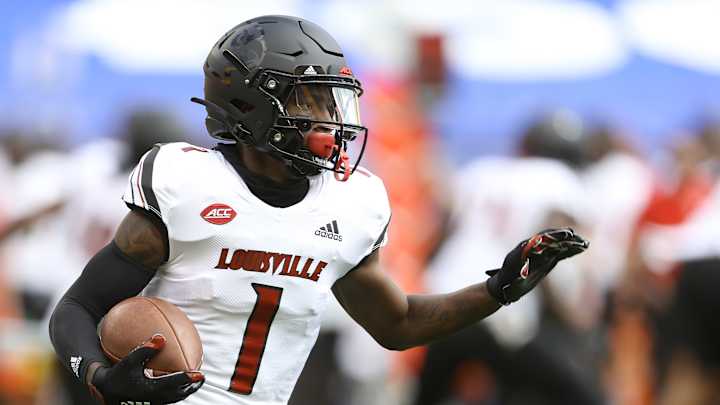Seahawks 2021 Draft Profile: Tutu Atwell

Losing four receiving threats - Greg Olsen, Jacob Hollister, David Moore, and Phillip Dorsett - to retirement and free agency thus far, the Seahawks are in need of adding more depth to quarterback Russell Wilson’s arsenal of weapons. Of the 10 transactions they’ve made through the first nine days of free agency, only one has nabbed a pass-catcher: tight end Gerald Everett.
While Everett appears capable of being the tertiary receiving option the Seahawks have been looking for, they’re still lacking in their actual receiving corps outside of DK Metcalf and Tyler Lockett. Behind the star duo is 2020 sixth-round pick Freddie Swain and roughly two or three wide-open roster spots up for grabs for the five wideouts they have signed to reserve/future contracts, as well as anyone else they may bring in this offseason.
But with T.Y. Hilton most recently coming off the board, the free agent market has significantly thinned out. The next best solution, naturally, would be the draft, but the Seahawks currently possess just three picks in next month’s event. Fortunately for them, receiver may be the deepest position group in this draft class.
Assuming they trade down from their first pick at No. 56 to accumulate more capital, a player they may have a chance to snag in the latter half of day two is Louisville speedster Chatarius “Tutu” Atwell. In any other draft, Atwell may be a first-round talent, and there are even some outlets that project that’s where he’ll eventually land a month from now. But this pool of NFL hopefuls may be too saturated for that to become a reality for Atwell, pushing him further down draft boards and possibly into the collective laps of a team like the Seahawks.
In the event he does become a realistic option for Seattle, let’s take a look at what he brings to the table.
Strengths
The two biggest positives that will jump off the page with Atwell is his speed and college production. Louisville’s Pro Day isn’t until March 30, so we haven’t seen official 40-yard dash times on Atwell, but the expectation is it will turn some heads; he’s been reported to have clocked in at 4.27 in the past. Utilizing that elite-level speed, he put up a whopping 2,303 receiving yards and 20 touchdowns on 139 receptions in his three years in college.
He shows excellent burst off the line of scrimmage and quickly gets opposing defenders off-balance with his twitchiness, often creating separation before he’s even hit his top speed. By that point, Atwell has blown through the second level and down the field, spelling doom for opposing defenses if he doesn’t outrun his quarterback’s arm strength.
Despite his small 5-foot-9, 165-pound build, he plays bigger than his size. He’s a willing blocker in the run game and viciously fights for the ball in contested catch situations. He also has a knack for the occasional acrobatic catch, displaying good reaction time, athleticism, and improvisation on the fly.
Atwell excels in open space as well, eluding defenders one-on-one and picking up chunk yardage after the catch. His extraordinary acceleration makes him a danger on short drags and behind the line of scrimmage on screens and jet/fly sweeps, giving him all the tools to be an offensive swiss-army knife.
Weaknesses
Stellar athletic profile aside, there are a few concerns that may drop Atwell down draft boards in this deep class. The most glaring being his size, which - at the NFL level - could be a problem for him from a physical standpoint.
At times in college, he struggled with getting jammed at the line by defenders. He was easily pushed off his spot in these instances, inhibiting him from building up his speed and thus, eliminating him from the equation of the play. How he adapts to the even more unforgiving nature of the NFL will ultimately be the key to determining whether he’s a starting slot receiver or a mere gadget player on the back half of a team’s receiving corps.
There is still a ton of room for Atwell to improve from a technical standpoint as well, which isn’t unusual for a recent quarterback-to-receiver convert. His route running, especially, leaves more to be desired, occasionally failing to get in and out of his breaks crisply. Fundamentally, his ball security must also get better, though he did improve on his drop tendencies with just three in 2020.
Fit in Seattle
The Seahawks love speed all over the field, but perhaps no more than at receiver. They already pose two of the most athletically-gifted wideouts in the league with Metcalf and Lockett. With the best deep-ball thrower in the NFL under center, adding Atwell to that mix could make Seattle's already excellent downfield attack virtually unfair.
He's also an ideal fit for new offensive coordinator Shane Waldron's scheme. In a conversation with Seahawk Maven's Matty F. Brown, Benjamin Solak of the Draft Network name-dropped Atwell as one of the better prospects in this year's draft in regards to his ability to properly run jet/fly sweeps—a staple of the Sean McVay offense Waldron is expected to fairly emulate in Seattle.
Atwell has the potential to be a dynamic threat at the highest level, but some of his weaknesses - as outlined - may drive him down to the Seahawks. If so, given their current situation at the receiver position, it's hard to imagine they don't strongly consider pulling the trigger.

Reporter and editor covering the Seattle Seahawks for All Seahawks. Host of Locked On Mariners.
Follow danegnzlz